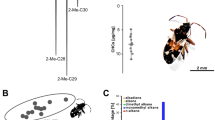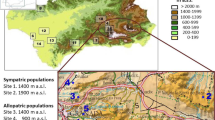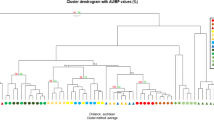Abstract
Butterfly caterpillars in the lycaenid subfamily Miletinae are predators of ant-tended Homoptera, yet they lack specialized secretory and call-production organs crucial to ant association in other lycaenids. Here, we address the question of how miletine caterpillars have invaded the ant–Homoptera symbiosis through a study of the only New World miletine, Feniseca tarquinius, a predator of the wooly aphid Prociphilus tesselatus. Previous interpretations have suggested that F. tarquinius and other miletine caterpillars avoid ant aggression by concealing themselves under silken webs. In contrast, our field data indicate that F. tarquinius caterpillars are less likely to be concealed in the presence of the ants Camponotus pennsylvanicus and Formica obscuriventris than in the absence of ants, although caterpillar and ant behaviors vary between years. Chemical analysis and behavioral assays suggest that chemical camouflage, not physical concealment, is responsible for the ants’ failure to detect and remove F. tarquinius caterpillars from aphid colonies. Analyses by gas chromatography indicate that the cuticular lipid composition of caterpillars are similar to that of their aphid prey, although it varies with prey species. Behavioral assays confirm that solvent extracts of F. tarquinius caterpillars and P. tesselatus aphids evoke similar behavioral responses in C. pennsylvanicus ants. Chemical camouflage is well known in social parasites of ants, but the present study represents one of a few documented cases where chemical deceit is important to interactions with ants outside the nest.





Similar content being viewed by others
References
T. Akino R. Mochizuki M. Morimoto R. Yamaoka (1996) ArticleTitleChemical camouflage of myrmecophilous cricket Myrmecophilus sp. to be integrated with several ant species Jpn. J. Appl. Entomol. Zool. 40 39–46
T. Akino J. J. Knapp J. A. Thomas G. W. Elmes (1999) ArticleTitleChemical mimicry and host specificity in the butterfly Maculinea rebeli, a social parasite of Myrmica ant colonies Proc. R. Soc. Lond., B Biol. 266 1419–1426
R. A. Allan R. J. Capon W. V. Brown M. A. Elgar (2002) ArticleTitleMimicry of host cuticular hydrocarbons by salticid spider Cosmophasis bitaeniata that preys on larvae of tree ants Oecophylla smaragdina J. Chem. Ecol. 28 835–845 Occurrence Handle10.1023/A:1015249012493 Occurrence Handle12035930
P. R. Atstatt (1981) ArticleTitleLycaenid butterflies and ants: Selection for enemy-free space Am. Nat. 118 638–654 Occurrence Handle10.1086/283859
Clark, A. H. 1926. Carnivorous butterflies. Annual Report of the Board of Regents of the Smithsonian Institution, 1925, pp 439–508.
K. R. Clarke (1993) ArticleTitleNon-parametric multivariate analyses of changes in community structure Aust. J. Ecol. 18 117–143
C. B. Cottrell (1984) ArticleTitleAphytophagy in butterflies: Its relationship to myrmecophily Zool. J. Linn. Soc. Lond. 79 1–57
W. S. Creighton (1950) ArticleTitleThe ants of North America Bull. Mus. Comp. Zool. 104 1–585
J. H. Cushman V. K. Rashbrook A. J. Beattie (1994) ArticleTitleAssessing benefits to both participants in a lycaenid–ant association Ecology 75 1031–1041
K. Dettner C. Liepert (1994) ArticleTitleChemical mimicry and camouflage Annu. Rev. Entomol. 39 129–154 Occurrence Handle10.1146/annurev.en.39.010194.001021
P. J. DeVries (1988) ArticleTitleThe larval ant-organs of Thisbe irenea (Riodinidae) and their effects on attending ants Zool. J. Linn. Soc. Lond. 94 379–393
P. J. DeVries (1990) ArticleTitleEnhancement of symbioses between butterfly caterpillars and ants by vibrational communication Science 248 1104–1106
P. J. DeVries (1997) The Butterflies of Costa Rica and Their Natural History, II: Riodinidae Princeton University Press New Jersey
P. J. DeVries (2001) ArticleTitleButterflies Encycl. Biodivers. 1 559–573 Occurrence Handle10.1006/rwbd.1999.0041
P. J. DeVries I. Baker (1989) ArticleTitleButterfly exploitation of an ant–plant mutualism: adding insult to herbivory J. N. Y. Entomol. Soc. 97 332–340
W. H. Edwards (1886) ArticleTitleOn the history and the preparatory stages of Feniseca tarquinius Can. Entomol. 18 141–153
T. Eisner K. Hicks M. Eisner (1978) ArticleTitle“Wolf-in-sheep’s clothing” strategy of a predaceous insect larva Science 199 790–794
G. W. Elmes T. Akino J. A. Thomas R. T. Clarke J. J. Knapp (2002) ArticleTitleInterspecific differences in cuticular hydrocarbon profiles of Myrmica ants are sufficiently consistent to explain host specificity by Maculinea (large blue) butterflies Oecologia 130 525–535 Occurrence Handle10.1007/s00442-001-0857-5
B. E. Holldobler E. O. Wilson (1990) The Ants Belknap Press Cambridge, MA
R. W. Howard R. D. Akre W. B. Garnett (1990) ArticleTitleChemical mimicry in an obligate predator of carpenter ants (Hymenoptera: Formicidae) Ann. Entomol. Soc. Am. 83 607–616
C. R. Huxley D. F. Cutler (Eds) (1991) Ant–Plant Interactions Oxford University Press New York, NY
R. L. Kitching (1987) ArticleTitleAspects of the natural history of the lycaenid butterfly Allotinus major in Sulawesi J. Nat. Hist. 21 535–544
S. Lahav V. Soroker A. Hefetz (1999) ArticleTitleDirect behavioral evidence for hydrocarbons as ant recognition discriminators Naturwissenschaften 86 246–249 Occurrence Handle10.1007/s001140050609
D. Liang J. Silverman (2000) ArticleTitle“You are what you eat”: Diet modifies cuticular hydrocarbons and nestmate recognition in the Argentine ant, Linepithema humile Naturwissenschaften 87 412–416 Occurrence Handle10.1007/s001140050752 Occurrence Handle11091966
C. Liepert K. Dettner (1993) ArticleTitleRecognition of aphid parasitoids by honeydew-collecting ants: the role of cuticular lipids in a chemical mimicry system J. Chem. Ecol. 19 2143–2153 Occurrence Handle10.1007/BF00979653
C. Liepert K. Dettner (1996) ArticleTitleRole of cuticular hydrocarbons of aphid parasitoids in their relationship to aphid-attending ants J. Chem. Ecol. 22 695–707 Occurrence Handle10.1007/BF02033579
H. Malicky (1970) ArticleTitleNew aspects on the association between lycaenid larvae (Lycaenidae) and ants (Formicidae, Hymenoptera) J. Lepid. Soc. 24 190–202
U. Maschwitz W. A. Nassig K. Dumpert K. Fiedler (1988) ArticleTitleLarval carnivory and myrmecoxeny, and imaginal myrmecophily in miletine Lycaenids (Lepidoptera, Lycaenidae) on the Malay Peninsula Tyo to Ga 39 167–181
N. E. Pierce (1995) ArticleTitlePredatory and parasitic lepidoptera: carnivores living on plants J. Lepid. Soc. 49 412–453
N. E. Pierce M. F. Braby A. Heath D. J. Lohman J. Mathew D. A. Rand M. A. Travassos (2002) ArticleTitleThe ecology and evolution of ant association in the Lycaenidae (Lepidoptera) Annu. Rev. Entomol. 47 733–771 Occurrence Handle10.1146/annurev.ento.47.091201.145257 Occurrence Handle11729090
Scudder, S. H., 1889. The Butterflies of the Eastern United States and Canada with Special Reference to New England. Vol. 1–3, 24+ 1958 p, 88 pls.
T. L. Singer (1998) ArticleTitleRoles of hydrocarbons in recognition systems of insects Am. Zool. 38 394–405
R. R. Sokal F. J. Rohlf (1981) Biometry W.H. Freeman San Francisco, CA
R. K. Meer ParticleVander D. P. Wojcik (1982) ArticleTitleChemical mimicry in the myrmecophilous beetle Myrmecaphodius excavaticollis Science 218 807–808
M. J. Way (1963) ArticleTitleMutualism between ants and honeydew-producing homoptera Annu. Rev. Entomol. 8 307–337 Occurrence Handle10.1146/annurev.en.08.010163.001515
J. H. Zar (1999) Biostatistical Analysis Pearson Education Upper Saddle River, NJ
Acknowledgments
We thank Frank Laib for help with gas chromatography, Dave Kinnamon for access to his property, and Gretchen Meyer and the UWM Field Station for advice, support, and facilities. We acknowledge Samuel Scudder and Henry Edwards for reporting, a century ago, initial observations that inspired this work. This research was supported by a National Science Foundation Graduate Research Fellowship and a University of Wisconsin-Milwaukee Graduate School Fellowship.
Author information
Authors and Affiliations
Corresponding author
Rights and permissions
About this article
Cite this article
Youngsteadt, E., Devries, P.J. The Effects of Ants on the Entomophagous Butterfly Caterpillar Feniseca tarquinius, and the Putative Role of Chemical Camouflage in the Feniseca–Ant Interaction. J Chem Ecol 31, 2091–2109 (2005). https://doi.org/10.1007/s10886-005-6079-2
Received:
Revised:
Accepted:
Published:
Issue Date:
DOI: https://doi.org/10.1007/s10886-005-6079-2




